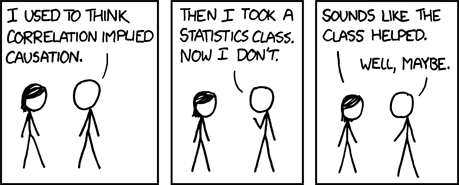Improving Technology Conferences Using Data
Many large technical conferences have a resource-allocation problem: It’s hard for attendees to get into all the sessions they want to attend. The solution is to do a better job with session scheduling and room allocation, assigning the more popular sessions to bigger rooms. The challenge: popularity is usually unknown. Or is it?
This year, I volunteered to help the PASS Program Team predict ahead of time which PASS Summit 2014 sessions would be most popular so the team could schedule those sessions in larger rooms.
Questions to Ask
We started with some key questions. Can we predict how many people will attend each session? More precisely, can we predict the percentage of attendees that will attend each session?
We needed to find which factors correlate with session attendance. Is it the time of day? Session topic? Speaker level? The track? The popularity of the speaker? Their session feedback scores?
It was clear what we needed: data!
The Program Team started collecting data about sessions from Summits 2011 through 2013, including:
- Session details (title, track, level, speakers)
- Session attendance and room size
- Session start/end times
- Session feedback scores
- Speaker popularity (Twitter followers, Bing results count)
- (derived) The percent of each event’s attendees in each session
This took quite a bit of time and the use of various tools: Python, Excel, and SQL. Finally, we had a CSV file with all of the different inputs.
Note: for privacy reasons, the session feedback scores have been removed from this file, even though they were used in the analysis.
For this initial project, we began with a fairly limited data collection; we didn’t try to do topic modeling for session content, include the amount of demos, or do more advanced feature extraction (such as betweenness centrality of Twitter followers).
Analysis and Discovery
Now it was time for the fun part: analyzing the data. One of the best ways to understand data is to visualize it. Let’s see the breakdown of the most popular sessions, defined as the percentage of PASS Summit that’s in each session.
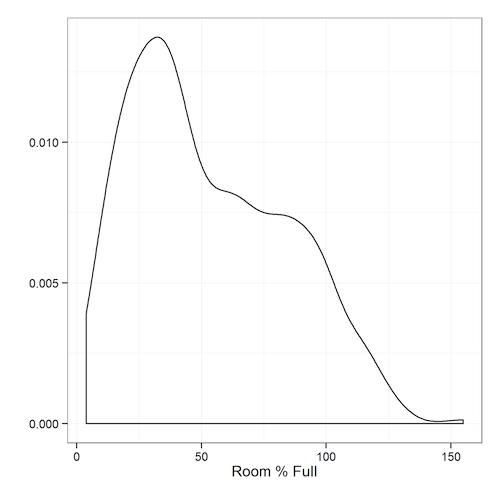
We can see that the data isn’t normally distributed; there are some overcrowded sessions, and a bunch of sessions with decent attendance. Very few sessions are almost empty.
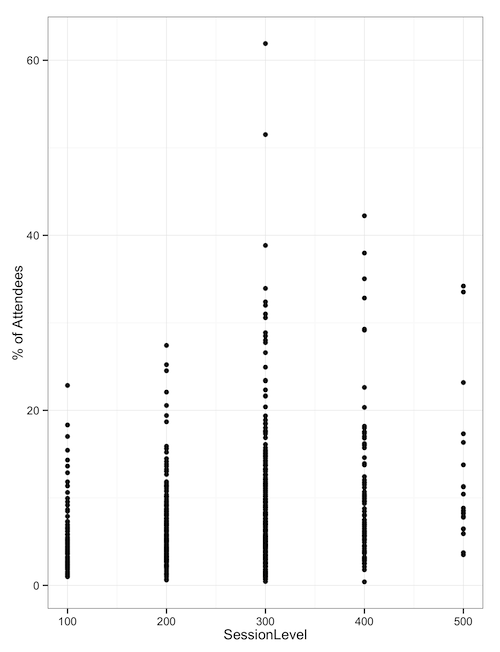
When we look at the percentage of attendees based on the session level of sessions attended, we can see that the 300-level and 400-level sessions have the most popular outlying sessions - the ones we need ballrooms for.
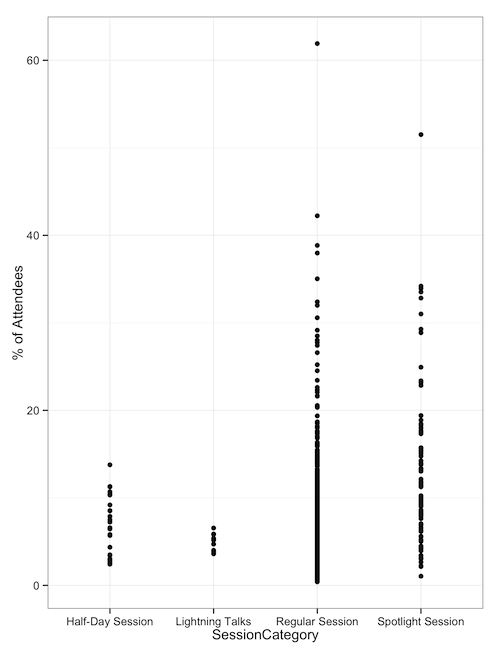
When we look at sessions by category type, such as half-days, Lightning Talks, regular sessions, and ‘Spotlight’ sessions, we see that regular and spotlight sessions are the ones with outliers. Half-day sessions and lightning talks don’t draw huge crowds.
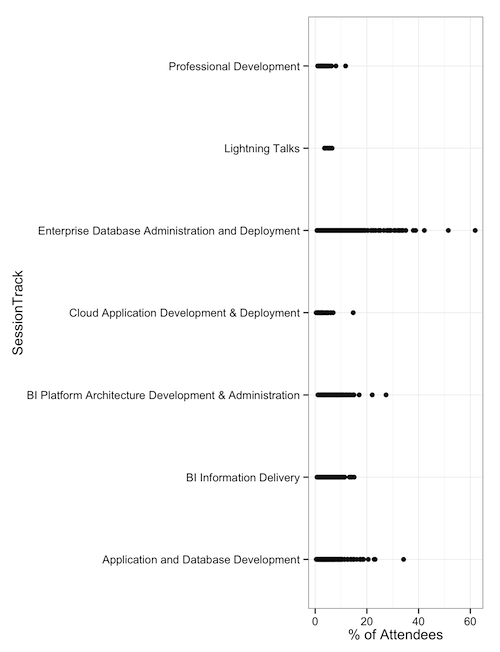
Finally, when we look at session tracks, we can see that DBA-focused sessions have drawn our largest attendance. This might be enough for some folks to make a decision: Put 300-level DBA sessions in the ballrooms. But from this analysis, we still don’t know whether the track or level is enough of a factor to matter.
Bring in the Machines
Our data set has a mix of categorical data (track, talk type, length) and numeric data (speaker Twitter follower count, session feedback scores, search engine popularity, etc. ). Many of the features are correlated. Our data isn’t normally distributed. What we needed was a machine learning algorithm that could do regression given these constraints, which is predicting a numeric value (rather than just a true/false value).
There are several machine learning algorithms that work in this space, but one of my favorites for this scenario is random forests. It’s a variant of decision-tree algorithms that uses bagging and cross-validation to avoid overfitting.
One way to test the accuracy of a prediction is to predict things where we already know the answers. We can see that of the 800-odd sessions being analyzed, we can predict their attendance with a roughly 20% error rate. That means a session with a predicted attendance of 200 would have between 160 to 240 people.
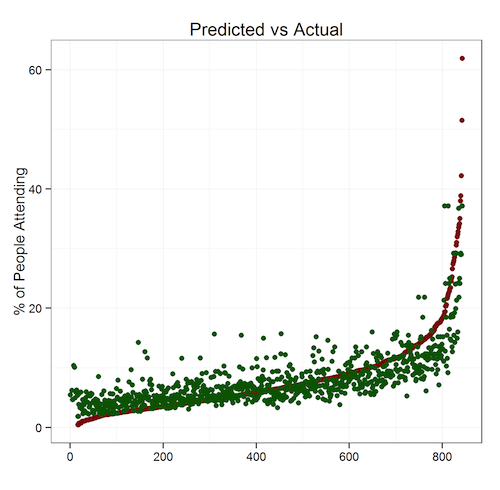
Because we’re trying to predict which sessions are unusually popular, a 20% margin of error is acceptable. Running these algorithms on the 2014 sessions data produced this output. One of the key findings: popular speakers draw big audiences regardless of topic.
We could, in theory, use a series of linear equations (or a programmatic solver) to solve this for us and build a schedule automatically. However, this is our first pass, so we didn’t want to go that far. We had predicted attendance numbers for each session; that was enough.
How Did PASS Use This Data?
With the forecasted attendance numbers, the Program Team got to work. They first assigned the sessions with the highest predicted attendance to the biggest rooms (the ballrooms) and then worked down the list. Once the first pass of the schedule grid was filled, the team made adjustments, taking into account other considerations, including topic dispersion and speaker schedule/travel restrictions.
Of course, no optimization problem like this is ever finished. So, the Program Team’s going to be collecting actual session attendance numbers, look at other inputs, and will improve the model for the future.
Results
The true test of a prediction is to compare it to reality In this case, we have the predictions before Summit from my earlier analysi. I now have the conference data on attendance and attendee feedback.
Let’s analyze session attendance and compare them with predictions.
Where Is Everybody
How many people were attending Summit at different times?
The most popular times were midday (5,400 on Wednesday) and early afternoon (4,300 on Thursday). The mornings were relatively empty. Fridays were quieter as well, with less than 1,300 people in attendance.
Measuring Error
With any prediction project, the definition of an error metric is critically important. There are a few classic examples:
- The difference between prediction and reality
- The percentage difference between prediction and reality
- Root mean squared error (RMSE)
It turns out my predictions were wildly bad. Some sessions had a predicted attendance of 323..and 12 people showed up. That’s just awkward.

Redefining Error
My predictions of sessions were inaccurate using common error metrics. They were also useful.

Overcrowded sessions are worse than empty sessions. It’s OK for a session room to be half empty. It’s only awkward when a room is 85% empty or so.
However, it’s really bad when a session is even 5% over capacity, because it means people are standing, getting turned away, etc.
Let’s redefine “error” to mean underprediction: when more people show up to a session than predicted:
There were just 2 sessions that underpredicted (the ones above the dotted line, above).
Musical Chairs
People don’t sit right next to each other at conferences. It’s not considered polite (because of elbow room, not enough deodorant, etc). A room will feel full far before all of the chairs are occupied.
Let’s count the number of sessions that were over 90% full.
| Year | Sessions | % of Sessions |
|---|---|---|
| 2011 | 32 | 14% |
| 2012 | 50 | 17% |
| 2013 | 51 | 17% |
| 2014 | 18 | 8% |
That’s an improvement. Let’s look at our success criteria: sessions that are 20-89% full:
| Year | Sessions | % of Sessions |
|---|---|---|
| 2011 | 181 | 77% |
| 2012 | 202 | 67% |
| 2013 | 196 | 65% |
| 2014 | 154 | 64% |
We can see that the % of sessions with a good attendance range stayed the same. That’s because we increased our other failure criteria: rooms that are less than 20% full:
| Year | Sessions | % of Sessions |
|---|---|---|
| 2011 | 23 | 10% |
| 2012 | 51 | 17% |
| 2013 | 55 | 18% |
| 2014 | 67 | 28% |
We’ve traded a painful problem (overcrowded sessions) for an awkward one (mostly-empty rooms). We also had 18 sessions that were over-crowded. Clearly we should do better next year.
However, this year’s PASS Summit had the fewest over-crowded rooms since 2011. During the conference, I heard anecdotes that rooms were better allocated this year. I’ll call that a win.

Keep Going
There’s no reason I should be the only person looking at this data. The #sqlpass community is large and technically savvy. To that end, I’ve made all of the raw data public.
I didn’t account for the time of day, conference fatigue, or the presentation topics. There’s quite a bit of additional work we can do to improve session attendance predictions and room allocation.
Session Feedback
Attendees also left feedback after a session
Note: due to PASS policy, I am not allowed to release session rating information that can identify a particular session or speaker. I have done my best to anonymize session data while retaining its full analysis information.
Feedback Loops
The way to give feedback for Summit sessions this year was using an online form, built into the PASS Summit app. People attended sessions 36,445 times and filled out 5,382 feedback surveys, for a response rate of 14.8%. That’s a pretty low percentage, spotty Wi-Fi and cell connectivity could be a contributing factor.
How much can we trust this data? How closely does it reflect reality?
We Don’t Know
This is Statistics 101: sample sizes and populations. If we assume that the feedback is broadly typical of all attendees, then our margin of error is 1.62% (given 99% confidence).
The true margin of error is higher. The people who provide feedback are often the ones who loved a session, or hated it. Session feedback is anonymous, and without demographic and longitudinal data for each response, there’s no way to know.

If I was a dyed-in-the-wool statistician, I’d stop here. Instead, I’ll continue with the assumption that the data represents all attendees’ opinions.
What’s the Distribution of Feedback for Each Question?
Presenters get high marks.
Rankings
Session speakers are often keenly interested in their ranking. Did they get the #1 most highly-rated spot, or the #3?
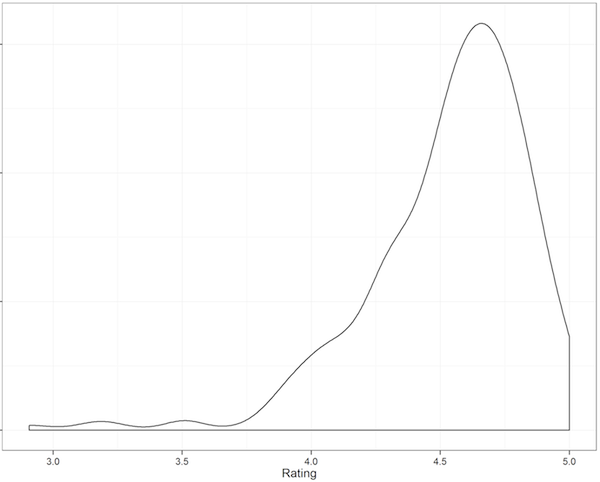
Due to privacy concerns, I can’t release ratings with session names or speakers. However, I can tell you the percentile rankings.
| Percentile | Overall | DBA Track | BI Info Track | BI Platform Track | AppDev Track | ProfDev Track |
|---|---|---|---|---|---|---|
| 95th | 4.90 | 4.85 | 4.86 | 4.87 | 4.93 | 5.00 |
| 90th | 4.84 | 4.84 | 4.81 | 4.81 | 4.87 | 4.96 |
| 80th | 4.76 | 4.74 | 4.75 | 4.73 | 4.80 | 4.87 |
| 70th | 4.71 | 4.70 | 4.70 | 4.67 | 4.73 | 4.80 |
| 60th | 4.66 | 4.64 | 4.60 | 4.62 | 4.68 | 4.72 |
| 50th (Median) | 4.61 | 4.61 | 4.55 | 4.52 | 4.66 | 4.67 |
| 40th | 4.53 | 4.53 | 4.46 | 4.48 | 4.61 | 4.61 |
| 30th | 4.47 | 4.39 | 4.40 | 4.44 | 4.58 | 4.56 |
| 20th | 4.33 | 4.24 | 4.34 | 4.29 | 4.51 | 4.50 |
| 10th | 4.16 | 4.07 | 4.25 | 4.23 | 4.33 | 4.42 |
Note: rankings do not include the environment scores, since that is outside of a speaker’s control
Correlations
A few weeks ago I asked folks on Twitter what questions they had that could be answered from session feedback.
A few things to remember:
- A correlation of 1 or -1 means they are 100% linked
- A correlation of 0 means there’s no relationship whatsoever
- Correlation != Causation.
Environment Score and Speaker Performance
Is there a correlation between the “environment” score given by attendees and the speaker rating?
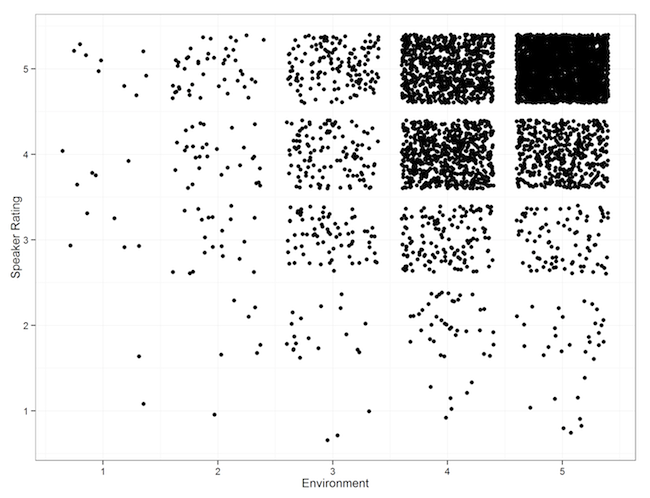
There’s a weak correlation, (R^2 = 0.377). That’s not enough to do much with.
Enough Material and Session Length
Is there a correlation between the enough-material question and the session length?
I don’t know. There’s no information about which sessions ended early or late, unless you want to measure them using the online session recordings. There’s not enough information when comparing regular sessions to half-day sessions to derive anything useful.
Attendance and Popularity
Cynicism and Timing
Do certain time slots produce higher scores?
There’s no real correlation between time slots and scores. There is some variation of scores between times, but there’s no pattern I can find to it.
Speak Up, Speak Up
Do certain times of day have higher completion rates for feedback?
Feedback is higher in the morning, but the pattern isn’t consistent. There’s also an outlier for the vendor-sponsored sessions that include breakfast.
The Packed-Room Effect
Does a packed room (room % full) correlate with higher or lower ratings overall? No! The correlation is very weak (R^2 = 0.014), and not significant (p-value 0.09).
The Bandwagon Effect
Do popular sessions (total session attendance) correlate with higher scores?
Sort of. The linkage is very weak, with a correlation of 0.031 (p-value 0.012)
Consistency
Is past performance an indicator of future success? In other words, did repeat performers improve, stay the same, or get worse?
Let’s compare each year’s data with the speaker’s overall score:
Most speakers stay within 0.5 of their average score. There are very few wild improvements or wild disappointments. However, a 0.5 difference is the difference between a 4.95 rating (amazing) and a 4.45 (in the 40th percentile).
Future Research
This work is not done. Data always leads to more interesting questions. There are many places to take this information, including:
- Comparing speaker ratings with the scores given to abstracts to see how well session selection is doing. Let’s provide data about the Speaker 47 problem.
- Adding topic and content analysis to look for patterns by session topic
- Investigating data-driven ways for the PASS community to build and identify upcoming speakers (cough SQLSaturdays cough)
- Investigating how to better gather feedback during sessions. The ~14.8% feedback rate isn’t good.
- Considering letting the PASS community vote on sessions they’d like to see. This is potentially controversial, but it does have the benefit of having sessions directly represent what the (voting) PASS community want to see.
- Using information about popularity and time slots to better allocate sessions and figure out what potential changes could be made to the schedule.
- Telling me I’m wrong. This is great - I’d rather be told I’m making an error than let that error lead to bad decisions.
- Providing more transparency around the session selection process.
Keep Going
There’s no reason I should be the only person looking at this data. The #sqlpass community is large and technically savvy. To that end I’ve made almost all of the raw data public. The only piece missing is the speaker ratings for individual sessions and speakers; that has been anonymized as much as possible at PASS’s request.
You can contact me anytime via Twitter (@DevNambi) or email ([email protected]).
Published 30 September 2014
